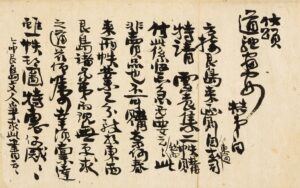Independence activists during the late Joseon Dynasty tended to be upright and conservative, often displaying formal and conventional handwriting. However, religious figures such as Son Byeong-hui, the leader of Cheondogyo, and Han Yong-un, a Buddhist monk, were exceptions, showing unique handwriting styles. Their distinct spiritual perspectives likely contributed to their unconventional scripts. Yet, there were individuals with even more unique handwriting, such as Na Cheol, the founder of Daejonggyo, and notable followers like Kim Gyo-heon, Yi Yu-rip, Jang Do-bin, Jo Wan-gu, and Ahn Hee-jae. Their writing took on a square, almost snake-like form, moving in a distinct, coiling pattern.
Na Cheol’s handwriting exudes grandeur with its perfect balance, forming a square shape that reflects a majestic energy. The Tang Dynasty scholar Yu Gongquan once said, “If the heart is upright, so too will be the brush.” While square handwriting can sometimes suggest a lack of flexibility, drive, or a tendency toward timidity, Na Cheol overcame these potential shortcomings with his bold strokes, rhythmic variations, and harmonious blend of straight and curved lines. The curving lines, reminiscent of a snake’s slither, convey warmth, love, and sensitivity, while the strictness and precision in certain parts reveal his adherence to principles, tenacity, and upright character. Daejonggyo, as both a national religion and a significant anti-Japanese movement, embodied his commitment to Korea. When the Japanese ordered the dismantling of Daejonggyo, Na Cheol chose death, leaving a will explaining his decision and ending his life through a method known as *paegibeop* (closed-breathing technique). His life and death were acts of moral conviction, entirely dedicated to the nation.
Na Cheol’s handwriting features narrow spacing between characters but ample space between lines. In graphology, the spacing between letters reflects the mental and physical distance a person needs to feel at ease. People who maintain close character spacing, such as Benjamin Franklin, Abraham Lincoln, and Franz Kafka, are often introspective, rigid in their thinking, highly self-aware, and strict in their self-expression. Meanwhile, wide line spacing suggests a cautious, thoughtful, and frugal nature. Na Cheol, with his narrow character spacing and broad line spacing, was likely someone who was strict with himself but warm toward others. His pursuit of logic and principles further solidifies his image as a true religious leader.

